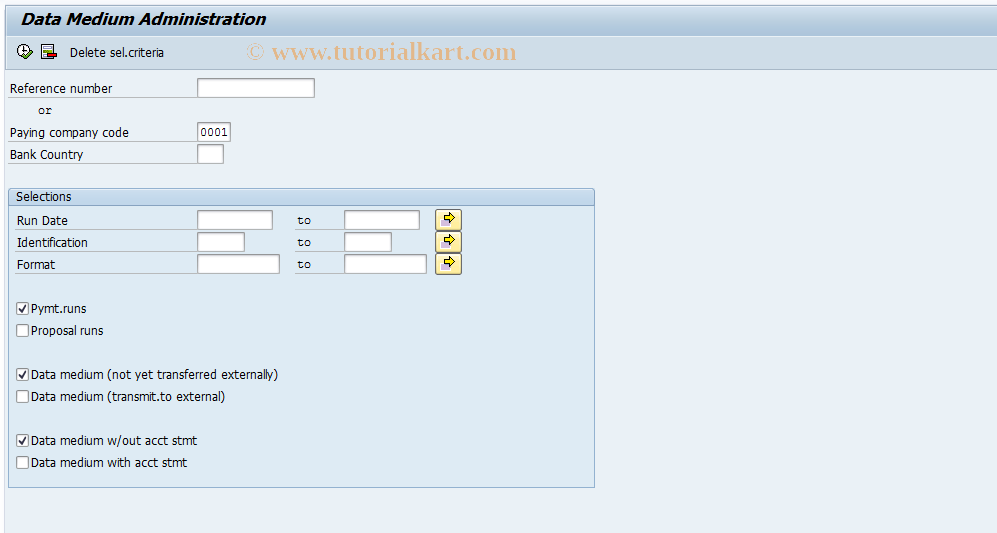
Skip to end of metadataGo to start of metadata
- Output in File System
the created file to be saved in the file system of the application server and not in the TemSe in the SAP System (SAP Note 1104567). - Output in the TemSe
If required, the file created can be held within the SAP System (saved in TemSe, not filed in the file system), and therefore protected from external access. The file can be downloaded to the user's file system via DME administration.

This web page collects information on how to work with HR TemSe Objects. HR TemSe Objects are a specialization of TemSe objects, used for HR Data. The main differences: HR TemSe objects contain a header in the first line (transparent when using the function module RPTSOPEN, the header uses the structure RPTSINFO); HR TemSe objects have a naming convention for the TemSe. For example, if you manually delete table entries from the spool and TemSe tables, delete spool and TemSe objects from the file system. The terminations of report and transaction also cause these inconsistencies. Also an incorrectly executed client transport can also lead to inconsistencies in the TemSe and spool. SP12 SAP tcode for – TemSe Administration. Here we would like to draw your attention to SP12 transaction code in SAP.As we know it is being used in the SAP BC-CCM (Use Subcomponents in Basis) component which is coming under BC module (BASIS).SP12 is a transaction code used for TemSe Administration in SAP.
File name
relevant SAP Note 1234970
You can use exit 21 see consulting note 1234970. In exit 21 (transaction OBPM3), you can change the file name during runtime.
At event 21, you can add to a header or prefix of the payment medium that was created by event 20 by changing entries in table T_FILE_OUTPUT.
The file name can be changed using changing parameter C_FILENAME.
Import parameter I_XFILESYSTEM specifies if the file should be output to the file system or the TemSe file that was entered on the selection
screen of the generic payment medium program.
Known issue for Output:
FZ205 : note 1786620
SAP Note 1224437 PMW: When are separate payment advice notes created?
It is a complex topic, it should be consered a lot of settings like note point 4 in note 305414
4. In payment program Customizing you have made an entry in field T042E-ANZPO (Line items per form) for the form data (Transaction FBZP / Pmnt methods in company code / Form data) and have not set the flag 'Pmnt advice if form is full' (T042E-XAVIS) A value < 99 denotes that only this number of items can be paid per form. If you define for example the value '4', then four items are always paid collectively.
Furthermore, bear in mind that an additional line is generated for an item which contains a line item text (item text BSEG-SGTXT) beginning with '*', provided that you want the text output in the form. Thus, if you want to pay four items, each containing a line item text beginning with '*', a total of 8 items are generated. Consequently, only two documents (i.e., four items) could be paid at a time per form in the above-mentioned example.
- Lack of space for generating XML files.
Solution :note 1932233
to restrict the number of payments in a Payment Medium Workbench (PMW) file.
TemSe is a store for temporary sequential data; that is, objects that are not normally permanently held in the system are stored in the TemSe.
The spool system uses the TemSe to store output data temporarily. The spool system uses the TemSe to store output data temporarily. You can set whether the spool data is to be stored by TemSe in the SAP database or in the file system (for more information, see Storage Methods for Spool Objects in TemSe).
TemSe Objects
Temse Sap
Every TemSe object consists of a header entry in table TST01 and the actual object. This can be stored in the file system (for example, job logs) or in table TST03 (for example, HR data).
There are the following TemSe objects, among others:
Spool requests (TemSe Name: Spool....)
Job logs (TemSe Name: JOBLG...)
Objects from other applications, such as Human Resources (TemSe Name: HR)
An object whose name begins with KONS; this is object is constantly used by report RSPO1043 and should never be deleted (SAP Note 98065)
Temse Sap Erp
A Spool Request as a TemSe Object
With spool requests, you can decide whether the object is stored in the file system or in table TST03. By default, a spool request is stored in table TST03. You have the following options to define a storage location for spool requests:
Sap Temse Object Was Closed Remotely
Using the profile parameter
rspo/store_location;
where you can specify file system (parameter valueG
) or table TST03 (parameter valuedb
)In the device definition of an output device (
Edit
File Storage
)
Temse Sap Log
Spool requests also have entries in table TSP01 (Spool Requests) and possibly in table TSP02 (Output Requests).
Features of TemSe
Temse In Sap
Storage of temporary objects, such as spool requests and job logs
Administration and display of temporary objects
Note
TemSe cannot administer objects that require more than two gigabytes of storage space, regardless of whether the objects are stored in the database or in the file system. Spool requests of a size greater than two gigabytes must therefore be split into several smaller requests.
Note
Note that TemSe is not an archiving system. The maximum permissible number of spool requests is limited. The default value is 32000 and can be increased to 2 billion. However, this can affect performance, depending on the capacity of the database and the database host (see SAP Note 48284). You should therefore use the print list archiving option for spool requests.
You can check space usage to avoid storage space problems.
